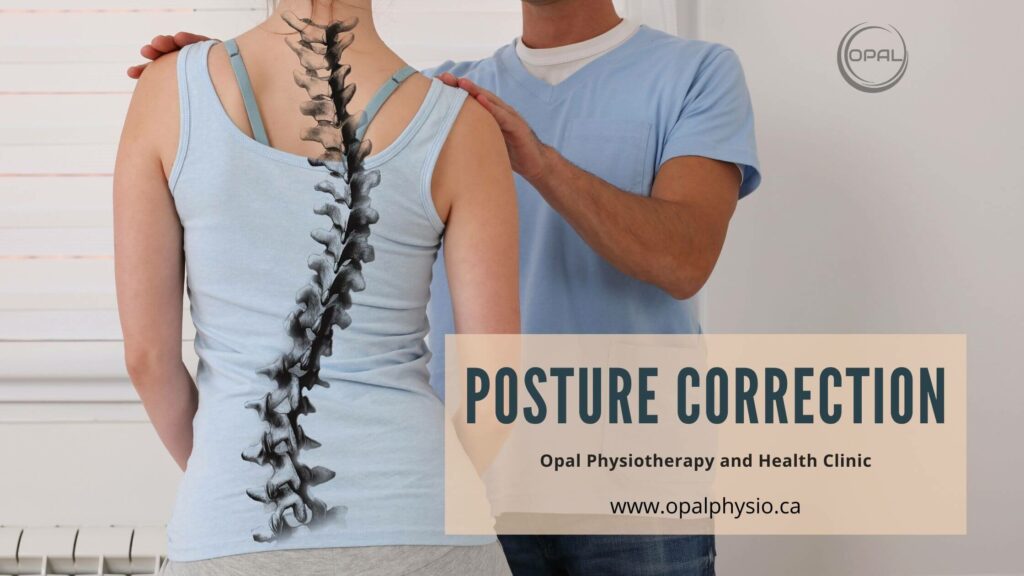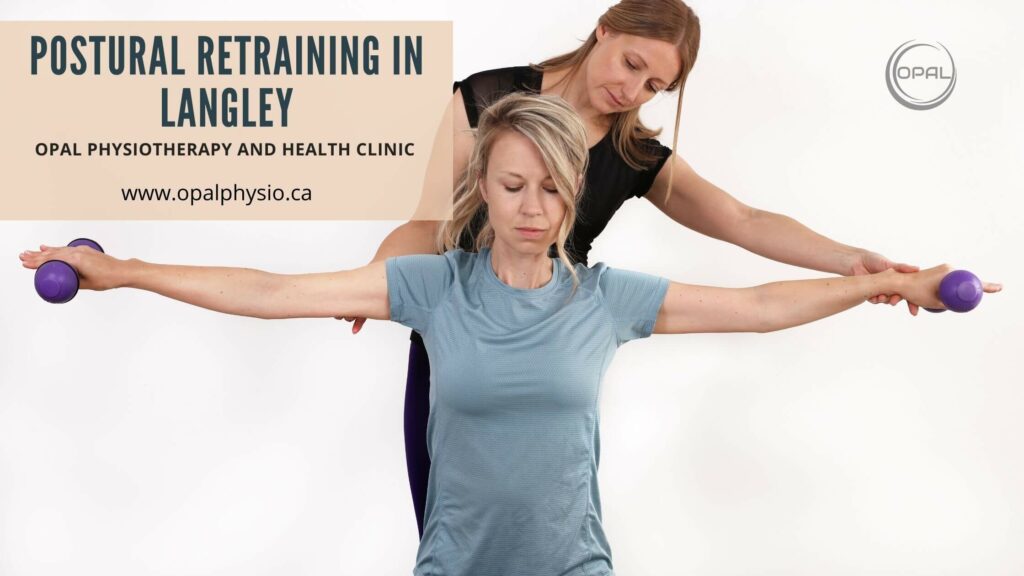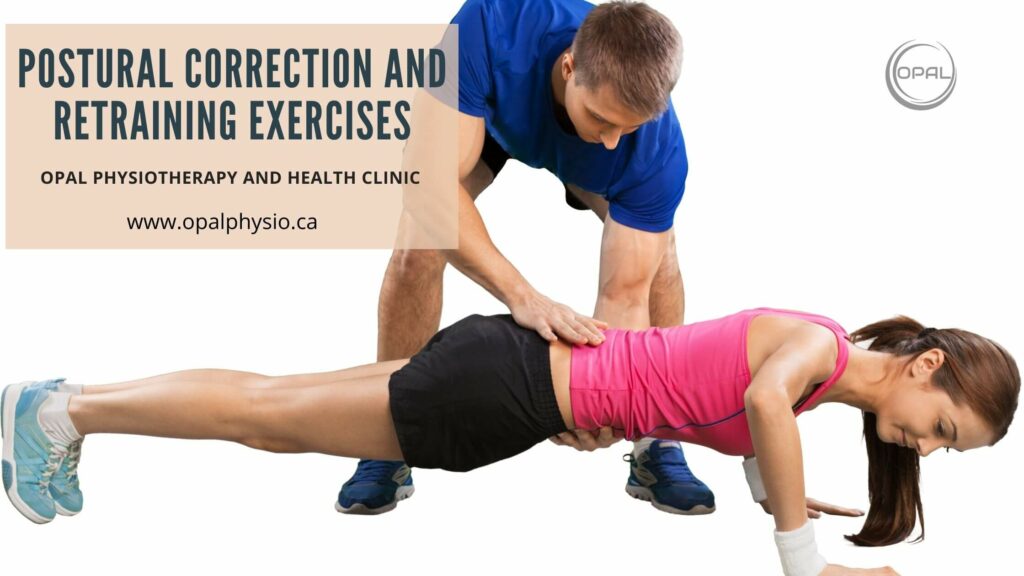Posture Correction in Langley
Best posture correction physiotherapists in Langley, BC
At Opal Physio In Lower Mainland BC our therapists can help people fix their bad postures and address underlying musculoskeletal health problems. Our physiotherapist will work with you to determine what caused your postural problem and can identify how significant it is. They will then make a physical therapy treatment plan just for you.

Why posture correction?
Incorrect postures have become an enormous issue that affects many people. It can cause pain, headaches, reduced focus and concentration and the inability to perform daily activities efficiently. The situation worsens with increased prolonged sitting postures and reduced active lifestyle. Many patients find that they need help from a physiotherapist for posture correction treatment.
In addition, recent technological advances have led to the population struggling with more pain and dysfunction. This is due to prolonged periods spent glued to screens, desk work or holding their phone or mobile device, leading to poor posture.
Postural Correction Using Manual Therapy
The goal of posture correction physiotherapy treatment for men and women is to restore your muscle group from any imbalances leading to pain symptoms. Our physiotherapist uses a manual therapy approach and exercises to help reduce pain, increase joint mobility or flexibility, and improve posture and alignment.
Poor posture usually stems from a combination of:
Poor posture resulting from prolonged periods of sitting or standing can lead to pain and dysfunction, which may make day-to-day activities more challenging and are likely to worsen over time. Posture correction treatment can be helpful in addressing these issues
Physiotherapy treatment for postural correction Includes:
Postural Retraining
At Opal Physiotherapy, we can treat pain related to postural issues by providing postural retraining with awareness, lifestyle modifications, education, exercises, manual therapy, taping techniques etc.
We provide specific workout programs to gain strength and endurance in key muscle groups that can help improve long-term outcomes. We can also provide advice on ergonomics, which can help you improve your posture at work and at home.
We use posture correction techniques to improve joint and muscle function with mobilization, breathing exercises and sustained or dynamic stretching positions appropriate for every condition. Following the session, the therapist will also provide a home exercise program to help maintain and improve your posture.

Physiotherapy-based postural rehabilitation treatment is appropriate for all ages, from young to seniors. A personalized treatment plan will help you achieve the best results. For example, if you think you have poor posture and increased pain when sitting or standing prolonged, you will benefit from a full postural assessment.
Having an optimal posture through posture correction will help you improve pain and perform better with your function.
Postural Issues Commonly Identified and Treated with Physiotherapy
Forward head posture (FHP) is when the head droops forward and can lead to muscle tension in the neck, headaches, and sore upper back, neck and shoulder pain. It can also lead to pinched nerves causing arm pain. Forward head posture can result from poor ergonomics, prolonged periods spent sitting at desks, computers, driving or looking at your phone. FHP can also be caused by carrying heavy bags or purses on one side of the body. Forward head Syndrome is a muscle imbalance causing muscle tightness in the upper neck muscles that pull the top of the spine (cervical vertebrae) forward and from weakness in the anterior neck muscles.
Kypholordosis is when the vertebrae are asymmetrical and have lost their average height. Kypholordosis is typically caused by excessive curvature of the spine in one direction in the upper and lower back and can also be caused by disease or injury. In addition, this posture can cause weakness in the neck, abdominal muscles, buttock muscles and tightness to hip muscles.
Kyphosis is an exaggerated or excessive posterior curvature of your upper and mid-back. Kyphosis can happen for many reasons, including muscle imbalances and poor posture. To fix kyphosis, a person must strengthen their back muscles and stretch anterior muscles to reverse the curve using postural retraining.
Lordosis is a forward curvature of the spine in the lower back. It is characterized by an exaggerated arching in the back with an increase in pelvic tilt. It can be caused by issues in the hip joints, sacroiliac joint, and spine. In addition, lordosis may occur due to muscle atrophy or lack of movement. Lordosis is more visible in a normal standing position. The posterior iliac crest and the sacral area are most commonly affected by lordosis.
Forward-rounded shoulders are a postural adjustment that occurs when someone slouches for a longer duration. It is often seen in young adolescents due to a lack of bone development and muscle strength. The most common postural condition is caused by restricted movement in the scapula and the inability to maintain proper posture, from doing repetitive tasks such as typing or using a computer mouse, repetitive reaching, and after an injury to the shoulder joint causing neck, back and shoulder pain. The muscles around the chest and neck can become tight and need to be stretched.
Flatback is when the spine’s normal curvature is lost, causing the spine to be flat. These problems may arise due to weakness in the hip, back muscles and tight hamstring muscles.
Sway Back posture: In a swayback posture, your body weight shifts to the back of your hips, causing the lower spine and buttock muscles to lose strength. The most common causes are weak core muscles, a sedentary lifestyle, and chronic bad habits such as sitting.
Leg Length Discrepancies: The difference in leg lengths can happen when one leg is shorter than the other leg due to uneven weight distribution, which can cause back pain, shoulder pain, and knee pain. Additionally, people with a difference in height between their legs are more susceptible to injuries.
A true leg length discrepancy can be a result of disparity in bones. The apparent leg length difference can be from a shortening of muscle tissues and joints, making the leg seem shorter.
Scoliosis is when the spine is twisted and curved to the side. As a result, scoliosis causes the spinal column to be crooked or uneven, leading to muscle weakness and other complications on one side of the body. Scoliosis can be caused by numerous things, such as genetic conditions, abnormal growth, injury or illness and can be retrained and corrected at earlier stages.
The Importance of Professional Posture Correction
Good posture is crucial for maintaining long-term health and preventing various health issues, including muscle tension, pain, fatigue, and other common ailments. Professional posture correction by a physio can help individuals improve their posture and reap numerous benefits, both physical and psychological.
Benefits of Good Posture
- Reduced back pain: Incorrect posture is a significant risk factor for low back pain. Maintaining good posture can help alleviate this discomfort.
- Improved spine and neck health: Proper posture reduces the risk of back and neck pain, as it helps maintain the natural curves of the spine.
- Increased energy levels: Poor posture can negatively affect energy levels, resulting in fatigue. Practicing good body alignment may help you remain focused and energized at work.
- Better balance and stability: Good posture helps develop strength, flexibility, and balance in your body, leading to less muscle pain and more energy throughout the day.
- Injury prevention: Proper posture reduces stress on muscles and ligaments, decreasing the risk of injury.
- Enhanced self-esteem: Good posture can boost self-confidence, as demonstrated by a 2009 study.
- Improved mood: There is evidence that good posture can positively impact mood.
Preventing the development of poor posture
The primary cause of poor posture is a gradual decline in the alignment of your musculoskeletal system that gets worse over time. Regular exercise is the single most effective measure you can take to improve your posture.
It is possible to achieve and keep your ideal postural alignment with the use of a well-designed muscular training posture correction programme that works to maintain a balanced level of muscle tension across your whole body. In addition to helping you achieve optimal alignment, yoga may help you maintain balanced, strong, and flexible muscles and connective tissues in your body.
Posture Correction Exercises
Posture Correction Exercises (PCE)are commonly prescribed in physical therapy to rehabilitate the spine. Workouts are performed in a supervised setting or at home and are prescribed to patients after having identified postural issues, undergone spinal surgery, or sustained a back or neck injury. They’re designed to help straighten and restore the spine’s natural curves and encourage healthy alignment.
Exercises for posture correction can also include strength, flexibility and balance re-training programs. In addition, core muscle strength and cardio training are also very advantageous.

Frequently asked questions
We’ve got your back. Book a physiotherapy appointment today.
If you are suffering from posture problems or have questions about proper alignment of your spine or other postural issues and need help from a posture correction therapist in Langley, do not hesitate to call us at 604-532-7887 to know more and book an appointment.
